Adding Conditional Formatting Rules for OnePager Pro for Version 7.0
Contents
About Adding Conditional Formatting Rules
1) Use the following steps to add a conditional formatting rule or rules to the Conditional Formatting Rules form's grid:
2) From either the Task Bars or Milestones tab of the Chart Properties or Template Properties forms, click the Manage Rules... button:
3) You are now ready to add rules.
4) Click the Add Rule button and OnePager then creates a blank line in the window shown above so you can enter the first rule.
5) The line consists of three major components:
- a) the rule select and enable/disable checkboxes,
- b) the rule condition columns, and
- c) the rule action columns.
6) Adding, editing, copying, and deleting conditional formatting rules is very similar to the process for doing the same with respect to Conditional Import Filter Rules which are described at this link: Conditional Import Filters (Portal) 7.18.1-70.
7) The sections that follow cover each of the major components of a conditional formatting rule.
Rule Selection and Enable/Disable Checkboxes
Rule Selection Columns
1) The left most column in the grid, shown below, has the following function:
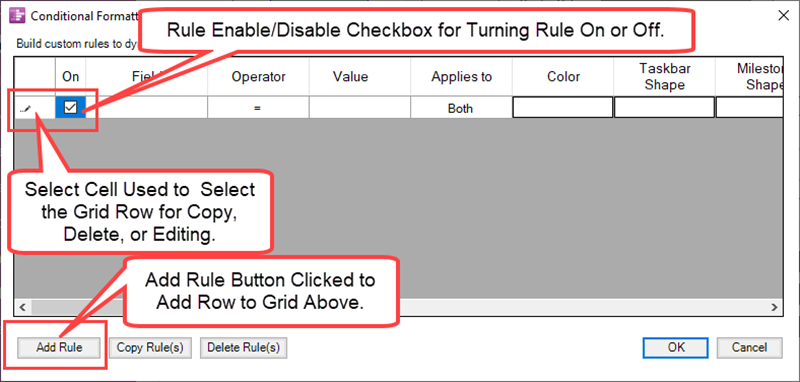
2) The Rule Select checkbox is provided so you can select the rule for editing, copying, or deletion.
Enable/Disable or On Column
3) The checkbox to the right of the Rule Select cell with the column heading of On provides control over turning the rule On and Off.
4) When the On checkbox in the column above is checked, the columns that include the rule conditions and actions are enabled.
5) It may become useful to have sets of rules in the Conditional Formatting Rules form and by turning them On or Off as required you can achieve a variety of results.
Rule Condition Columns
1) There are three rule condition columns as shown below:
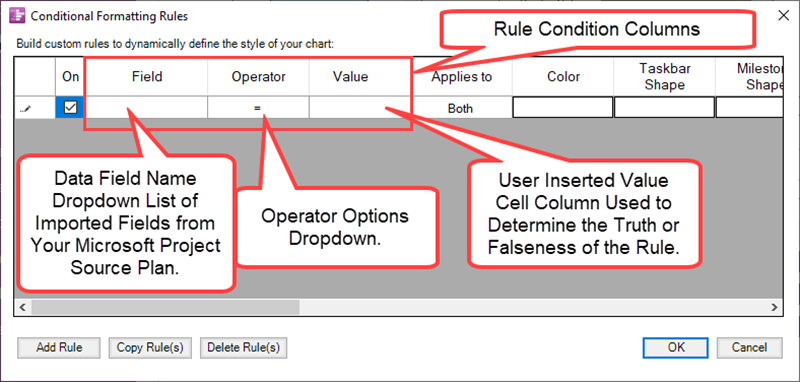
Field Column
2) In the Field column shown below is a dropdown that allows you to select the field from your Microsoft Project source plan.
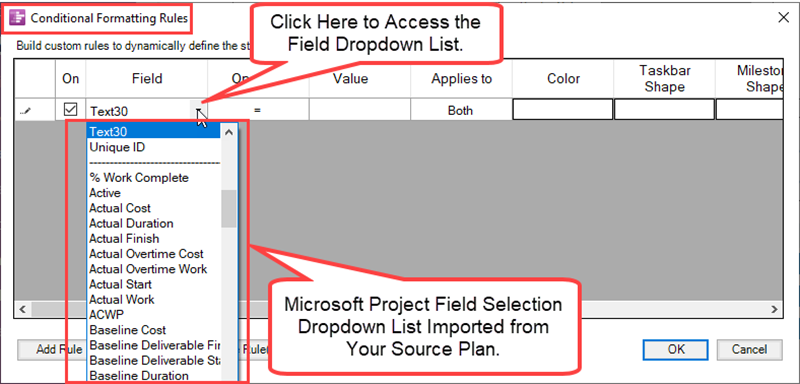
3) OnePager Pro imports all the fields from your Microsoft Project source plan so they are all available for use as a Field in a conditional formatting rule.
Operator Column
4)The Operator column shown below is a dropdown that allows you to pick from a list of operators depending on the data type of the Field selected as discussed above:
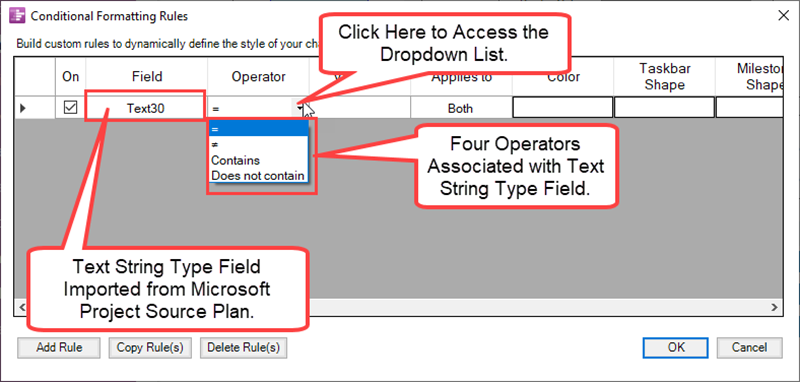
5) Since OnePager Pro knows the field type imported from your Microsoft Project source plan, the Operator column shows the appropriate operator selections when the dropdown menu above is accessed.
Text String Field Types
6) For Text String field types there are four operators:
- a) equal,
- b) not equal,
- c) Contains, and
- d) Does not contain.
Numeric and Data Field Types
7) For Numeric and Date field types, the operators are shown here:
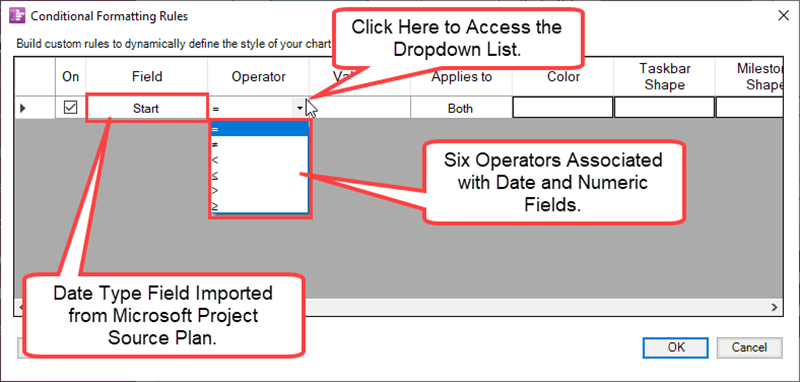
8) For Numeric and Date field types there are six operators:
- a) equal,
- b) not equal,
- c) less than
- d) less than or equal
- e) greater than
- f) greater than or equal
Boolean Field Types
9) For Boolean fields types (i.e., Yes/No, True/False) the operators are shown below.
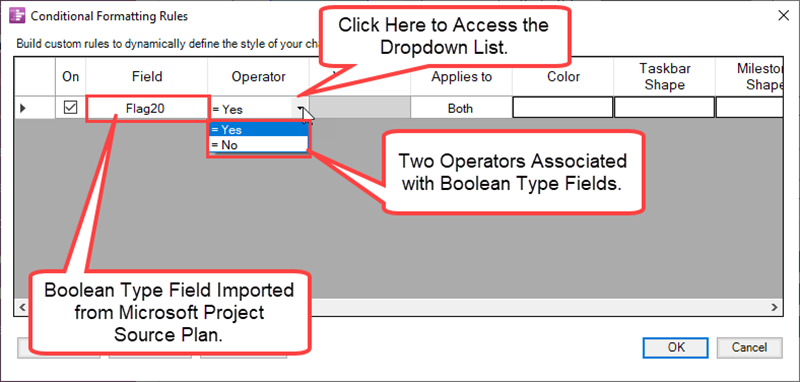
10) For Boolean field types there are two operators that can be expressed in two different ways as shown below:
- a) Yes or 1
- b) No or 0
11) The Value column is ghosted since selecting the Operator satisfies the need for a value.
Value Column
12) The Value column is the grid cell that you fill in that is the match desired against the Field Column given the contents of the Operator Column.
Boolean Field Types
13) The Value column is not used when the Field column is a Microsoft Project Boolean type.
Text String Field Types
15) For Text String type fields, any text that might appear in a Microsoft Project text string field can be typed in to the Value column's grid cell for a rule.
- a) Note that for string matches, it is permissible to have the Value column be a set of strings separated by commas.
- b) In this situation, the rule is matched when the column value is equal to any of the comma separated values.
- c) To make the comparison between text data specified in the Field column of the Conditional Formatting Rules form, OnePager trims leading and trailing white space such as blanks or control characters.
- d) However, OnePager does not trim excess white space within a valid character string.
Numeric Field Types
16) For Numeric type matches any integer or integer with a decimal fraction is permissible.
Date Field Types
17) For Date type matches the Value Column provides the standard OnePager calendar when you click in the Value Column and the Field Column is a date type field as shown below:
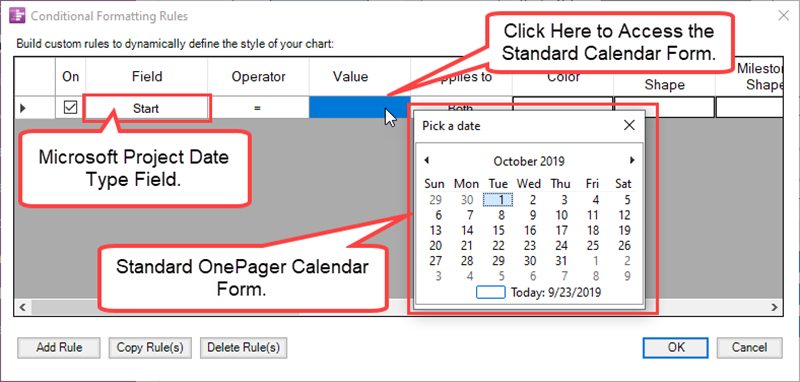
18) The Value column can be used to compare against today’s date by clicking the Today: ... checkbox in the Pick a date Calendar form shown above.
19) This is useful for establishing a rule where it is important to color or otherwise highlight a task whose Finish date is less than or equal to today’s date, for example.
Applies to Column
20) OnePager Pro performs the evaluation and then applies the formats specified in the rule to the tasks or milestones or both as determined by the Applies to column as shown here:
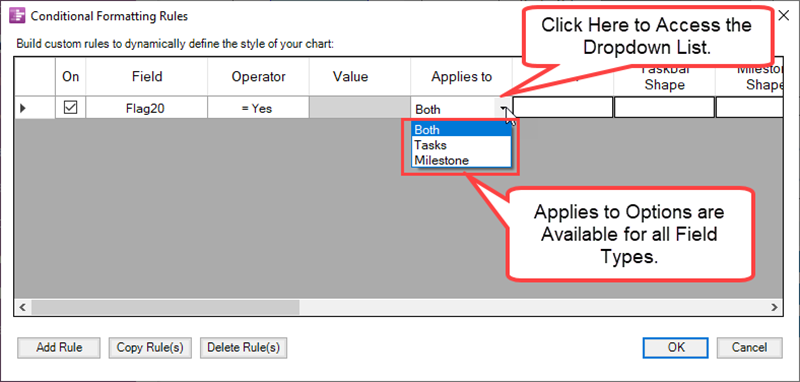
21) To tell OnePager whether to apply a rule to tasks, to milestones, or to both, there are three options for the Applies to column as shown below:
- a) Both
- b) Tasks
- c) Milestones
Rule Action Columns
1) To the right of the columns in the Conditional Formatting Rules form's grid Condition columns are nine (9) Action columns.
2) When a condition in the rule matches or is true all valid actions specified in the Action columns are applied to the task/milestones in the chart.
3) If the rule's condition does not match or is false, none of the actions specified in the Action columns are taken or applied to the task/milestones in the chart.
4) The Conditional Formatting Rules form's grid has a horizontal scroll bar allowing you to scroll to the left or right to being all of the nine Action columns into view within the grid as shown in the illustrations below:
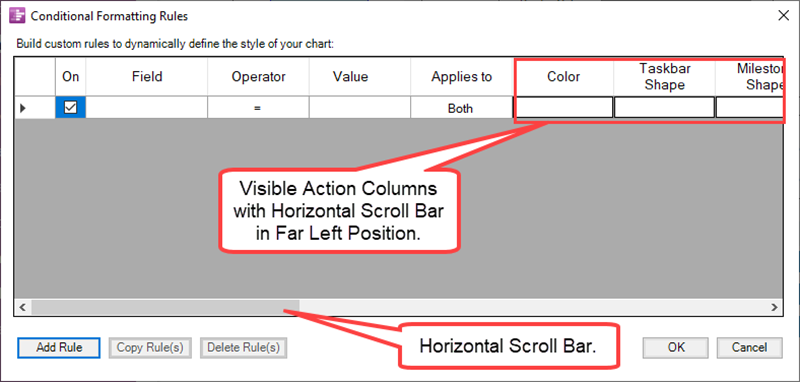
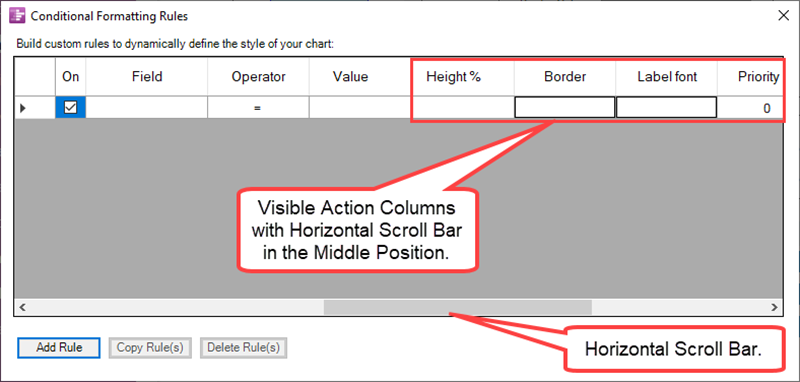
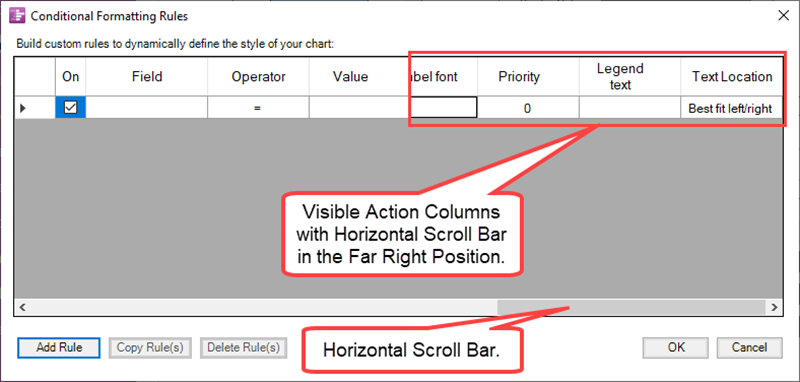
5) In the three illustrations above the thee Conditions columns of Field, Operator, and Value remain fixed in the grid and do not scroll left or right.
Related Links
Conditional Import Filters (Portal) 7.18.1-70
Manual Editing Task/Milestone Shapes and Text Labels (Portal) 9.0.1-70
Modifying Decorations on Tasks/Milestones (Portal) 10.0.1-70
The Chart Legend (Portal) 15.0.1-70
Editing with the Chart Properties form (Portal) 21.0.1-70
Managing Templates (Portal) 24.0.1-70
(11.3.1-70)